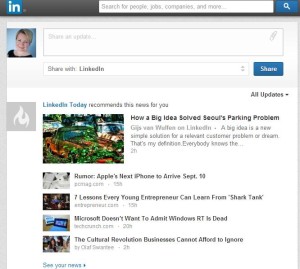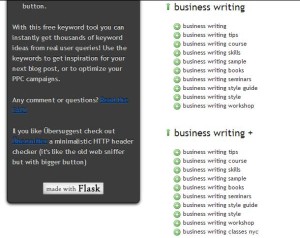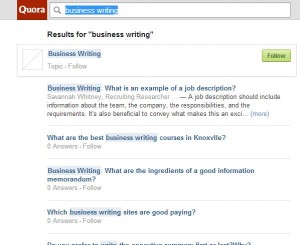 If you manage a business blog, you’ll know how challenging it is to come up with ideas for quality blog content.
If you manage a business blog, you’ll know how challenging it is to come up with ideas for quality blog content.
There are hundreds of content services, plug-ins and applications out there, but here are some of my favourite (and free) tools.
1. Google alerts
Set up Google alerts for your keywords to find web pages, news and blogs as they are published. I set mine to email me a summary of the best results once a week so they don’t clog up my inbox.
As well as inspiration for articles on the ‘hot’ topics in your niche, this is also a good way to find guest blogging opportunities.
2. LinkedIn
 I led a session on LinkedIn profiles recently (see my related post: 5 tips for writing a better LinkedIn profile) and it made me realise just how valuable this professional networking site is becoming as a marketing resource.
I led a session on LinkedIn profiles recently (see my related post: 5 tips for writing a better LinkedIn profile) and it made me realise just how valuable this professional networking site is becoming as a marketing resource.
Join selected groups in your niche and discover what they’re talking about. You can just passively watch group discussions for potential blog topics – known as ‘social listening’. Or join the conversation to establish yourself as an expert and influencer in your field.
Also, try using the advanced search functionality to find and follow companies and individuals under specific, relevant topics – ‘writing’ for example, or ‘customer service’. What are they talking about? Do they have publications or videos you can refer your readers to?
LinkedIn also recommends topic-specific news channels and influencers to follow – a good source of ‘real-time’ trending content.
To save time, customise your newsfeed to show only the updates you are interested in. On your home page, click on the ‘All Updates’ tab on the top right corner of your news feed, and select ‘Customize’.
3. Ubersuggest
 Ubersuggest is a free keyword search tool that finds hundreds of ‘long-tail’ variations. So a search for ‘writing+a’ returns ‘writing a cover letter’, ‘writing a business plan’’, ‘writing a resignation letter’ and so on.
Ubersuggest is a free keyword search tool that finds hundreds of ‘long-tail’ variations. So a search for ‘writing+a’ returns ‘writing a cover letter’, ‘writing a business plan’’, ‘writing a resignation letter’ and so on.
There are ten suggestions for each letter of the alphabet and the numbers 1-9. No indication of search volumes, but a good source of inspiration.
4. Q&A sites
 Question and Answer sites like Yahoo Answers and Quora help you find the questions (and answers) that people in your niche are discussing.
Question and Answer sites like Yahoo Answers and Quora help you find the questions (and answers) that people in your niche are discussing.
For example, if I type ‘business writing’ into Quora I see questions relating to executive summaries and proposals. I can turn these into a series of ‘How to…’ blog posts.
You can add value by summarising the top-rated answers in a well-written blog post – an easier format for readers to engage with.
5. Site analytics
Web analytics such as Google Analytics (free) usually include content statistics, such as most popular pages and search queries. Google shows you the exact search queries visitors typed into the search box when they found you. Some of these may surprise you. Keep an eye out for questions that you haven’t answered in your blog post.
Also check which of your posts are being shared most often on social networks such as Facebook, LinkedIn and Twitter. Build on these to maximize your exposure in social media.
There are many other ways to source quality blog content. To find out more, plus loads of practical advice about content marketing, check out my blogging for business course (ideal for organisations) or one-to-one coaching (suitable for both organisations and individuals).
Jakki
 Online training course Technical Report and Business Writing with The Institution of Civil Engineers (ICE).
Online training course Technical Report and Business Writing with The Institution of Civil Engineers (ICE).











 Certified by ICE (The Institution of Civil Engineers)
Certified by ICE (The Institution of Civil Engineers)
 Check out my online Udemy course and boost your business writing today:
Check out my online Udemy course and boost your business writing today: